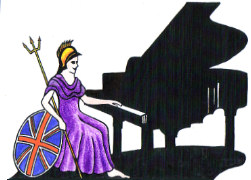A History of John Hopkinson, Piano Manufacturer

UK Piano Page

John Hopkinson started his business life in Leeds in 1835 as a music publisher. He moved to London in 1845, and in 1846 established Hopkinson Pianos. However, on his pianos it says "Est. in 1835," using the date from his beginning in Leeds as a music publisher. His first premises in London were at 70 Mortimer Street. His activities and locations after that are listed below.
The year 1851 is generally considered to mark the end of the classical piano building period and the beginning of the modern one. In that year, Hopkinson introduced a repetition action (patent number 13,652) in which by manipulating a key, "a hammer could strike so rapidly that it imitated the tremolo of a singer." The advertising prospectus was as follows:
"...a valuable improvement, which also shows the accurate and sensitive character of the mechanism is that the 'Tremolo' (similar in effect to that produced by the violinist or the voice of a finished singer) may be produced by this action upon the pianoforte."
Hopkinson brought out three patents, one of which was not published:
Hopkinson was one of the first to advertise a "Boudoir Piano." The term has meant various things. Steinway, for example, called their 6'2" grand by that name. Probably a little later than this Broadwood called their 7'6" grand a short grand and the 8'2" the full grand.
In 1843 the London firm of Rogers was founded. In 1911 George Rogers and J. & J. Hopkinson formed a business association. This was the start of a collaboration between two small manufacturers, similar to the partnerships we see today between the big manufacturers.
Hopkinson retired from business in 1869 and died on the 4th of April 1886. From this date Hopkinson Pianos went back into music publishing, which was run alongside the piano making enterprise. The music publishing side of the business lasted until 1895.
In 1856 Hopkinson's was struck by a fire, but both Broadwood and Collard provided some help to bring them back up to production.
Because of mechanisation and cut-price competition, standards of workmanship in the piano industry were declining fast. Hopkinsons realized this and in 1912 he devised an apprenticeship scheme in conjunction with London Technical College; the course was called "piano-making."
In 1923 the MD George Hermitage of Hopkinson died and the Rogers piano company, which had business ties with Hopkinson, bought the Hopkinson piano name and factory.
In 1963 Sidney Zender Ltd. acquired the trade names, manufacturing rights, all sales and matters of a technical nature of George Rogers and J. & J. Hopkinson. A new company was formed under the name of George Rogers & Sons, Tottenham Ltd., as distinct from the Zender Company.
The co-director and manager of the new company was H. B. Lowry, born in Berlin, the son of the owner of the Steinberg Company. He left Berlin in 1936, worked in the trade in England and joined the army in 1940, becoming one of the first British soldiers to reach Berlin. Rogers became agents for the Steinberg Company.
In the summer of 1980 Zender and Rogers ceased manufacture and it seems that the Zenders name was taken over by Barratt and Robinson.
In 1984 Bentley's began making Hopkinson, Rogers, and Zender pianos.
In 1987 Zender was completely taken over by Bentley's, which included Rogers Pianos and Hopkinson.
In 1993 Bentley's were acquired by Welmars.
On 14 July 2000 there was an official press release on the merger between Whelpdale Maxwell & Cod Ltd., London, and Woodchester Pianos, Stroud. The new company will be known as "The British Piano Manufacturing Company Ltd.," and would make Welmar, Knight, Broadwood, Bentley, Zender, Rogers, Hopkinson and Woodchester pianos.
On Monday, 7th April,2003 the British Piano Manufacturing Co. Ltd. went into liquidation. Production of Welmar, Knight, Broadwood, Bentley, Zender, Rogers, Hopkinson and Woodchester pianos stopped.
Barrie Heaton, MABPT, FIMIT, AEWVH (Dip.), MMPTA, CGLI (hon.) (USA)
© copyright 2007.
| SERIAL NUMBER | DATE |
| 15500 to 21100 | c1840 to c1850 |
| 21101 to 25000 | c1851 to c1860 |
| 25001 to 31900 | c1861 to c1870 |
| 31901 to 39000 | c1871 to c1880 |
| 39001 to 47400 | c1881 to c1890 |
| 47401 to 55200 | 1891 to 1900 |
| 55201 to 64000 | c1901 to c1910 |
| c1911 to c920 | 64001 to 72400 |
| 72401 to 80400 | c1921 to c1930 |
| 80401 to 86350 | c1931 to c1939 |
| 86351 to 89700 | c1940 to c1950 |
| 89701 to 91960 | c1951 to c1964 |
| 91961 to 92330 | c1965 to c1970 |
| 92331 to 93149 | c1971 to c1980 |
Barrie Heaton, FABPT, FIMIT, AEWVH (Dip.), CGLI (hon.) MMPTA, (USA)
© copyright 1999